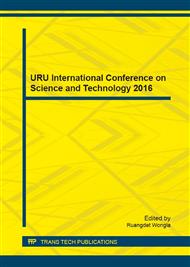p.70
p.75
p.82
p.91
p.98
p.103
p.108
p.114
p.121
Biodiesel Production from Sterculia foetida Oil by Using Solid Support Catalyst
Abstract:
In the present work, the properties of bioester from Samrong oil (Sterculia Foetida) and characteristics of cellulose solid catalyst are described. Heterogeneous catalyst was prepared via carbonization, sulfonation and purification giving solid catalyst as brown powder. Control parameters were time and temperature of carbonization and sulfonation reaction, ratio of sulfuric acid to solid material and weight of solid material. The optimized carbonization condition was 300 °C for 15 h. The sulfonation temperature was 150 oC for 18 h under N2 producing 7.99 mmol/g of acid concentration on solid catalyst. The acidity in water of solid catalyst after purification and drying was decreasing. The results of biodiesel production showed that the triglyceride could be converted to biodiesel directly by one-step sulfonic acid catalyzed process. The experimental condition of reaction process was 3.0 M of catalyst concentration with 9:1 M ratio of methanol to triglyceride at the temperature of 80 °C. This catalysts provided high reactivity of transesterification. The present procedure represents a simple method for biodiesel production with a short reaction time and with moderate conversion rate.
Info:
Periodical:
Pages:
98-102
Citation:
Online since:
October 2016
Authors:
Keywords:
Permissions:
Share:
Citation:


